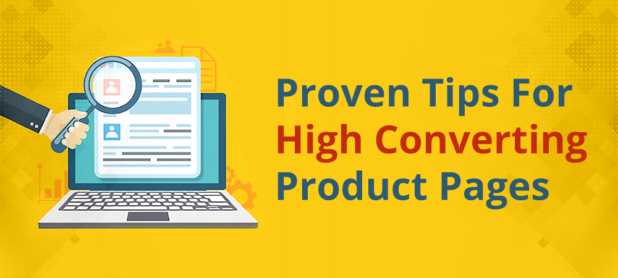
This guest post was submitted by Magento 2 Development Agency
When you kick start your digital venture, the primary purpose that drives all your efforts is to craft a portal that converts. During the process, a lot of focus will be on the landing page design and social media promotion, but there is one more important factor you can’t skip – the ecommerce product page.
The product page will define your product/service in entirety. From its history to its materials and variations, the product page will cover it all. According to Salsify, product content has become a higher priority among brand marketers. In 2018, practically all (99%) agreed that quality product content is vital to sales growth through digital channels.
Put yourself in your visitors’ shoes:
You come across a website selling smart phones. It’s ecommerce page lists all available phones with their specifications, customer reviews, photos from different angles, and even videos for in-depth evaluation. Simultaneously, you log onto another site recommended by a friend. It features only one photo of every phone, very little info about colors and specifications, and zero customer reviews.
You would prefer to purchase from the first website. Right?
Given the importance of product pages, it may make sense to consult professional assistance. For example, if you choose to use Magento as your ecommerce platform, an established agency like Magneto 2 Development Agency can help you set up your perfect web store.
Without further ado, let’s dive into ten proven tips that will help you curate high converting product pages:
1. Specify product name
Choose a name that defines your product in detail. The ideal product name contains keywords relevant to the product that will help inform your visitors. For example, if you are selling men’s watches on your website “Rolex Diatona Diamond Watch – Rose Gold” is more informative to users than “Rolex Watch”.
Remember, the product title must include the type of product (watch, phone, earrings, etc.) and its distinguishing features (brand, color, model type, size, etc.).
Good product titles not only inform your customers, but they also have the potential to improve your ranking in search engines. A descriptive title and well-written product details will result in a high click-through-rate (CTR), and can show up for a wider range of user searches.
2. Integrate Good Images
According to Field Agent, 83% of US smartphone users found product images and photos to be “very” and “extremely” influential.
Be sure to place the images next to or above the product description. This helps the prospects get an idea about their appearance. We strongly advise our customers to ingrain multiple photos on their websites. They must show it from different angles and must be zoomable. The more the images, the better it gets for the customer to know how the product works.
These days, we can leverage online tools to give a 360-degree view of the products. Services like Arqspin allow you to create 30-degree spins of your products and upload them on the site.
3. Describe the product
A stunning 55% of the visitors spend fewer than 15 seconds actively on a page. You have to convince them of the uniqueness and usability of your product within this span. Product descriptions will serve this function as it tends to inform and persuade people.
These descriptions help to engage visitors and prolong their stay on your site. You can provide secondary information like media endorsements, awards, manufacturing details, and traditional usage of the product.
Similar to the product name, its description also plays a role in improving SEO. Thus, it must contain a high volume of keywords.
4. Price
For many visitors, price is the drawing factor towards a product. They will look at the price and then decide if they should move further into the buyer’s funnel. It is, thereby, crucial to mention price details right there with the product description. If it is hard to find, the customers will become wary and log onto the rival’s website.
If there is an ongoing discount on the product(s), make sure you strike it through. Also, mentioning the offer on the homepage will compel users to know more. The key here is to highlight pricing. You can deploy different ways to do that.
5. Feature Options
Is your product available in different colors, sizes, and styles? Make sure you mention it along with your product. Place the feature options close to the call-to-action (CTAs). Bellroy does an incredible job of outlining each of their wallet options. It helps shoppers to make quick purchase decisions.
Plus, it is essential to mention which product is available and which is not. Showing stock levels will increase buyer urgency.
6. Shipping information
There will be a segment of shoppers who are hesitant to buy because they need products urgently. And they may not be sure if your company delivers products in their vicinity. This uncertainty about speed and cost can put off many buyers, causing a drop in the conversion rates.
It is essential to address all their concerns by providing all shipping details.
7. Calls to Action (CTAs)
If you don’t have buttons like “Add to cart” or “Buy now,” people will fumble around and exit. Place these CTAs at a point where they are clear. It has to stand out from other elements of the page and should be of considerable size. This will ensure that mobile users can easily click on it.
CTAs need to stand out on the page. You can use different colors and fonts to highlight it on the page. Given the increasing use of mobile phones to access websites, you should make sure that CTAs adjust with every screen size.
8. Leverage the power of product reviews
Incorporating legit reviews by loyal customers is the best way to ease the mind of worried visitors. It has been proven by various studies time and again. A recent survey revealed that 90% of the visitors read online reviews before visiting a website. And 67% stated that online reviews significantly impact their purchase decisions.
Therefore, you must work to integrate a section where customers leave their comments and opinions.
9. Show related products
Once the customer has added a product to their cart, they may browse further to explore other options. To make sure that they don’t head to the competitor’s website, you should show them other options. Showing related products might spark their interest, and they may decide to buy other products as well. For instance, if they have added a smartphone in their cart, you can show them the best earphones that go with such phones.
10. Improve loading speed Consumers expect fast load times when they enter a website. Research from Google in 2018 showed that 53% of mobile users would abandon a site that takes longer than three seconds to load. This can be quite problematic as most site pages take around 8 to 10 seconds for the download. To improve the loading speed, you can:
· Compress files and images
· Fix broken links
· Ensure that you use the latest version of CMS
· Reduce the number of HTTP requests
Along with these, there are many other tips that you can use. Experts will help you cover all such basics and optimize your store at its best capacity.
Final Words
There is no right or wrong way to create a product page that converts. Just make sure you are following the principles that will help you maximize your conversion rates.
We conclude it on an apt statement made by Jason Amunwa
“Each visitor that makes it to a product page represents the heavy lifting and money spent to get them there. The product page is not the time to squander that hard work. It’s up to you to create a user experience that gives the visitor what they need to become a customer.”



